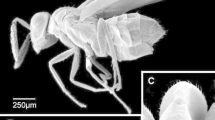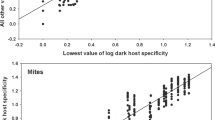Abstract
The host preferences and sex ratios ofMesochorus biotypes from Sweden and Colorado (U.S.A.) were studied in the field and laboratory. TheseMesochorus are secondary parasites ofBathyplectes spp., parasites ofHypera postica (Gyllenhal). The Colorado biotype is 100% thelytokous, and clearly prefersBathyplectes stenostigma (Thomson) as a host. Only an arrhenotokous biotype was positively detected in Sweden, and it appeared to preferB. curculionis (Thomson). However, some of the data suggest that the thelytokous biotype was probably also present in Sweden, at least inB. stenostigma. The behavioral differences and reproductive isolation of the thelytokous and arrhenotokous biotypes indicate that they are separate sibling species, even though they cannot yet be separated morphologically, and isozyme analyses were inconclusive (possibly due to a mixture of biotypes in Sweden).
Résumé
Des biotypes suédois et du Colorado (USA) deMesochorus furent étudiés sur le terrain et au laboratoire pour déterminer leurs hôtes préférentiels et les rapports des sexes. CesMesochorus sont les parasites secondaires deBathyplectes spp., parasites desHypera postica (Gyllenhal). Le biotype du Colorado est 100% thélytoque et son hôte de prédilection estBathyplectes stenostigma (Thomson). En Suède, nous n'avons trouvé qu'un biotype arrhénotoque qui semble préférerB. curculionis (Thomson). Toutefois, certaines de nos données suggèrent que le biotype thélytoque était aussi présent en Suède, tout au moins dansB. stenostigma. Les différences comportementales et l'isolement de biotypes à reproduction thélytoque et arrhénotoque indiquent qu'ils représentent des espèces fraternelles distinctes, même si elles ne sont pas morphologiquement différentes. L'analyse des isoenzymes n'a pas été concluante, probablement à cause du mélange des biotypes en Suède.
Similar content being viewed by others
References
Aeschlimann, J. P. — 1986. Distribution and effectiveness ofAnaphes diana [=Patasson lameerei] [Hym.: Mymaridae], a parasitoid ofSitona spp. eggs [Col.: Curculionidae] in the Mediterranean region. —Entomophaga, 31, 163–172.
Carlson, R. W. — 1979.Mesochorus nigripes. In: Catalog of Hymenoptera of America North of Mexico (K. V. Krombein ed.). —Smithsonian Inst., Wash. D. C., Vol. 1, 711.
Coseglia, A. F., Simpson, R. G. &Eklund, L. R. — 1977. Biology ofMesochorus nigripes, a hyperparasite ofBathyplectes spp. —Ann. Entomol. Soc. Am., 70, 695–698.
Cresson, E. T. — 1865. Catalog of Hymenoptera in the collection of the Entomological Society of Philadelphia from the Colorado territory. —Proc. Entomol. Soc. Phila., 4, 242–313.
Day, W. H. — 1969. Biological notes onDibrachys cavus, a secondary parasite attacking parasites (Bathyplectes spp.) of the alfalfa weevil in the eastern United States. —J. Econ. Entomol., 62, 1225–1226.
Day, W. H. — 1981. Biological control of the alfalfa weevil in the northeastern United States. In: Biological Control in Crop Production (G. Papavizas ed.). —Allenheld, Osmun, Totowa, N. J., 361–374.
Dysart, R. J. &Coles, L. W. — 1971.Bathyplectes stenostigma, a parasite of the alfalfa weevil in Europe. —Ann. Entomol. Soc. Am., 64, 1361–1367.
Dysart, R. J. & Day, W. H. — 1976. Release and recovery of introduced parasites of the alfalfa weevil in eastern North America. —USDA Prod. Res. Rpt., 167, 61 pp.
Debach, P. — 1969. Uniparental, sibling, and semi-species in relation to taxonomy and biological control. —Israel J. Entomol., 4, 11–28.
Ellsbury, M. M. &Simpson R. G. — 1978. Biology ofMesochorus agilis, an indirect hyperparasite ofBathyplectes curculionis. —Ann. Entomol. Soc. Am., 71, 865–868.
Flanders, S. E. — 1965. On the sexuality and sex ratios of hymenopterous populations. —Amer. Natur., 99, 489–494.
Hamlin, J. C., Lieberman, F. V., Bunn, R. W., McDuffie, W. C., Newton, R. C. & Jones, L. J. — 1949. Field studies of the alfalfa weevil and its environment. —USDA Tech. Bull., 975, 84 pp.
Hung, A. C. F., Day, W. H. &Hedlund, R. C. — 1988. Genetic variability in arrhenotokous and thelytokous forms ofMesochorus nigripes [Hym.: Ichneumonidae]. —Entomophaga, 33, 9–13.
Legner, E. F. — 1985. Effects of scheduled high temperature on male production in thelytokousMuscidifurax uniraptor [Hym.: Pteromalidae]. —Can. Entomol., 117, 383–389.
Legner, E. F. — 1987. Transfer of thelytoky to arrhenotokousMuscidifurax raptor Girault & Sanders [Hymenoptera: Pteromalidae]. —Can. Entomol., 119, 265–271.
Pike, K. S. &Burkhardt, C. C. — 1974. Hyperparasites ofBathyplectes curculionis in Wyoming. —Environ. Entomol., 3, 953–956.
Puttler, B. — 1966. Biological notes on some hyperparasites ofBathyplectes curculionis (Thomson). —J. Econ. Entomol., 59, 483–484.
Simpson, R. G., Cross, J. E., Best, R. L., Ellsbury, M. M. &Cosegelia, A. F. — 1979. Effects of hyperparasites on population levels ofBathyplectes curculionis in Colorado. —Environ. Entomol., 8, 96–100.
Sorenson, C. J. — 1934. Some hyperparasites of the alfalfa weevil parasite,Bathyplectes curculionis (Thoms.) occurring in the Unitah basin of Utah. —Utah Acad. Sci. Proc., 11, 249–251.
Stern, V. M. &Bowen, W. R. — 1968. Further evidence of a uniparental race ofTrichogramma semifumatum at Bishop, Calif. —Ann. Entomol. Soc. Am., 61, 1032–1033.
Webster, F. M. — 1912. Preliminary report on the alfalfa weevil. —USDA Bur. Entomol. Bull., 112, 47 pp.
Author information
Authors and Affiliations
Rights and permissions
About this article
Cite this article
Day, W.H., Hedlund, R.C. Biological comparisons between arrhenotokous and thelytokous biotypes ofMesochorus nigripes [Hym.: Ichneumonidae] . Entomophaga 33, 201–210 (1988). https://doi.org/10.1007/BF02372655
Received:
Accepted:
Issue Date:
DOI: https://doi.org/10.1007/BF02372655




